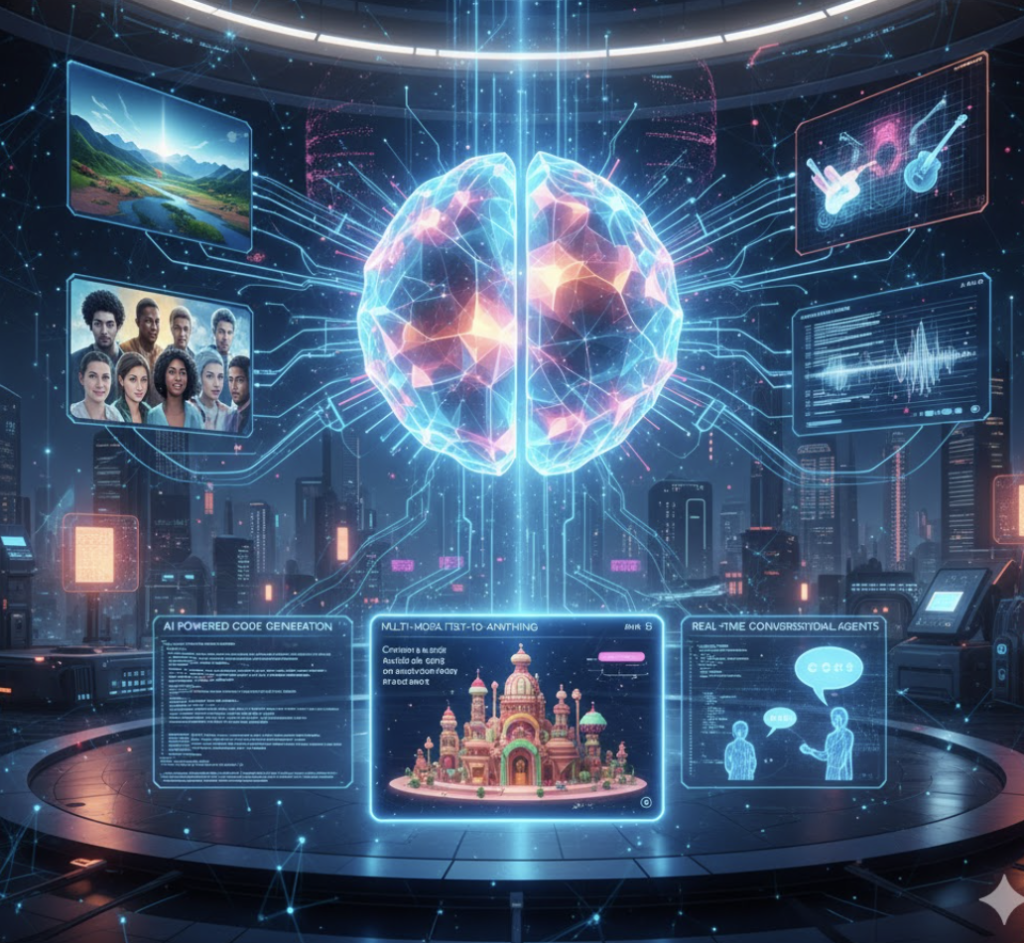
Introduction
If you’re even a little into tech, you’ve probably heard the term Generative AI everywhere — from Instagram reels to news headlines. But what is Generative AI really doing these days? How is it growing so fast? And why does every company suddenly want to jump on the AI train?
As a college student who loves exploring new technology, I’ve been following Generative AI updates closely. Trust me, what’s happening in this field is straight-up mind-blowing! From text-to-image models to AI music and video generation — Generative AI is no longer science fiction. It’s reality.
In this blog, we’ll explore everything new in Generative AI, what trends are shaping its future, and how it’s transforming industries faster than we expected.
🧩 What Is Generative AI?
Let’s start with the basics — Generative AI refers to artificial intelligence systems that can create new content. Unlike traditional AI, which only analyzes or predicts, Generative AI actually produces original data — like writing text, making art, composing music, or even designing 3D models.
Some popular examples include:
- ChatGPT – text generation
- DALL·E and Midjourney – image generation
- Sora by OpenAI – video creation
- Synthesia – AI avatars and presentations
These tools all fall under the umbrella of Generative AI, and they’re evolving rapidly.
🚀 Major Updates in Generative AI (2025 Edition)
1. Smarter, Faster, and More Creative Models
The biggest trend in Generative AI is model efficiency. Modern models are becoming smaller yet more capable. For example, OpenAI and Anthropic are developing lightweight Generative AI systems that run even on mobile devices — no cloud power needed!
This shift is making Generative AI more accessible to students, startups, and creators. You no longer need a supercomputer to experiment with AI art or build chatbots.
2. AI Video Generation Goes Mainstream
2025 has been huge for Generative AI in the video domain. OpenAI’s Sora and Google’s Veo have made realistic, full-motion video generation possible from simple text prompts. Imagine typing “a sunset at the beach with calm music,” and in seconds, a short film appears — that’s Generative AI magic!
3. Real-Time Collaboration with AI
Another cool update — Generative AI is now integrated into apps like Notion, Canva, and Microsoft 365 Copilot. These tools let you brainstorm, design, and edit with Generative AI in real time. It’s like having a digital partner who never gets tired.
4. Personalization through Fine-Tuning
Fine-tuning is the process of teaching Generative AI models your own data, so they talk and act like you. This is super popular among content creators, students, and brands. You can literally train a Generative AI model to write like you do or design graphics in your personal style.
5. AI Ethics, Copyrights & Safety Layers
With power comes responsibility. The more creative Generative AI becomes, the more questions arise about originality and ownership. Big companies like Adobe and OpenAI have started embedding “AI watermarks” to ensure transparency and protect content authenticity.
💡 Why Generative AI Matters for Students & Creators
For students like me, Generative AI is not just a buzzword — it’s a game-changer. Here’s why:
- Faster Learning – Using Generative AI chatbots helps understand complex topics instantly.
- Creative Boost – Tools like ChatGPT and Midjourney enhance ideas, projects, and designs.
- Career Growth – Knowing how to use Generative AI is now a top skill for internships and jobs.
- Personal Projects – From creating music to coding apps, Generative AI empowers solo creators.
Basically, Generative AI is turning every student into a mini-startup.
🔍 Top Trends Defining Generative AI in 2025
1. Multimodal AI
The new wave of Generative AI doesn’t just understand text — it processes images, sound, and video together. Multimodal models like GPT-5 and Gemini 2.0 are revolutionizing how AI interacts with humans.
2. AI Agents & Autonomous Systems
Imagine an AI that not only answers your questions but also performs tasks — booking tickets, writing reports, or managing emails. That’s the new age of Generative AI Agents.
3. AI-Generated Code & Apps
Developers now use Generative AI to write entire websites and mobile apps. Tools like GitHub Copilot X and Replit Ghostwriter speed up coding while maintaining quality.
4. Human + AI Collaboration
Instead of replacing humans, Generative AI is now assisting them. The trend is about co-creation — artists, writers, and designers using Generative AI as a creative partner.
5. AI in Education
Colleges are beginning to adopt Generative AI for teaching, tutoring, and exam prep. Personalized AI tutors can analyze a student’s learning style and create custom study plans.
⚙️ Industries Transforming with Generative AI
Generative AI isn’t limited to tech companies. It’s reshaping nearly every industry:
| Industry | Generative AI Applications |
|---|---|
| Marketing | Ad copy, designs, and video generation |
| Healthcare | Medical report summarization, image diagnostics |
| Education | Personalized learning assistants |
| Gaming | Dynamic storytelling and character generation |
| Fashion | AI-designed outfits and branding visuals |
| Music | Automated song creation |
| Film & Media | Script writing, storyboarding, video editing |
Each of these industries now relies heavily on Generative AI to boost creativity, save time, and cut costs.
🧠 Human Touch: Why Generative AI Still Needs Us
Even though Generative AI is insanely powerful, it still can’t replace human creativity and emotion. Sure, it can write poems or draw pictures, but it doesn’t feel what it creates.
That’s where we, the humans, come in. The best results happen when humans guide Generative AI with empathy, emotion, and context. The future isn’t AI vs humans — it’s AI + humans.
📊 SEO Impact: Generative AI in Content Creation
If you run a website or blog, Generative AI can boost your SEO like crazy. It helps you:
- Find keywords
- Write optimized articles
- Generate meta descriptions
- Design images for posts
Tools like Jasper AI, ChatGPT, and Copy.ai are making content creation 10× faster. But remember, Google values originality — so always review and humanize your Generative AI content before publishing.
🔮 The Future of Generative AI
The next few years will be wild. Generative AI will evolve beyond imagination. Expect to see:
- AI-powered virtual humans
- Real-time translation during conversations
- Instant film and game creation
- AI-built worlds in VR and AR
Basically, Generative AI is becoming the creative engine of our future. And if you’re someone who learns and adapts early, you’ll be part of that revolution.
🧩 Challenges Ahead
Even with all the excitement, Generative AI faces hurdles:
- Data privacy concerns
- Misinformation and deepfakes
- High computational costs
- Job replacement fears
That’s why ethical AI development is crucial. Governments and companies are working to create policies ensuring Generative AI remains safe and beneficial for everyone.
💬 Final Thoughts
As a college guy exploring the digital world, I find Generative AI both exciting and slightly scary. It’s like holding a tool that can create anything — words, art, videos — but also needs careful handling.
The truth is, Generative AI is not just another tech update. It’s a creative revolution redefining what humans can achieve with machines.
So, if you’re a student, creator, or entrepreneur — learn it, use it, and grow with it. Because the future belongs to those who understand Generative AI .
🔑 SEO Summary
- Focus Keyword: Generative AI
- LSI Keywords: AI updates, AI trends 2025, AI video generation, AI tools, AI content creation, future of AI, AI education, multimodal AI, AI in business, human and AI collaboration
- Meta Title: What’s New in Generative AI: Major Updates & Trends 2025
- Meta Description: Explore the latest Generative AI updates & trends in 2025. Learn how Generative AI is transforming industries, creativity, and the future of technology.



